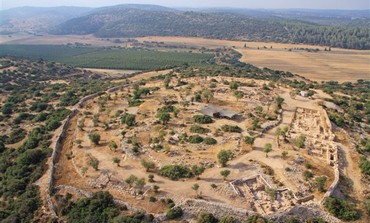(Read the post online for better viewing & lots of resources)

Archeologists dig up King David's palace
07/18/2013 10:40
Archeologists uncover palace from Kingdom of David Photo: Courtesy Israel Antiques Authority
A joint excavation led by the Hebrew University of Jerusalem and the Israel Antiquities Authorities discovered two of the largest structures ever uncovered from the Kingdom of Judea, the Israel Antiquities Authorities announced on Thursday.
Researchers Prof. Yossi Garfinkel and Saar Ganor identified one of the structures as a palace of King David, while the other as a large storage structure for the kingdom.
The excavation, which lasted seven years, gives evidence to state building and administrative organization during the time of King David.
According to Garfinkel and Ganor, "The ruins are the best example to date of the uncovered fortress city of King David," giving researchers a step up in understanding the origins of the kingdom of Judah.
"This is indisputable proof of the existence of a central authority in Judah during the time of King David," the archaeologists said.
Until now, no palaces were clearly attributable to the early tenth century BC. According to the archeologists, the site, named 'Khirbet Qeiyafa', was probably destroyed in a battle against the Philistines in 980 BC.
Recent excavations at Khirbet Qeiyafa, the first early Judean city to be dated by 14C, clearly indicate a well planned fortified city in Judah as early as the late 11th-early 10th centuries BC. This new data has far reaching implication for archaeology, history and biblical studies.
Khirbet Qeiyafa is located 30 km southwest of Jerusalem, on the summit of a hill that borders the Elah Valley on the north. This is a key strategic location in the biblical Kingdom of Judah, on the main road from Philistia and the Coastal Plain to Jerusalem and Hebron in the hill country. The city was constructed on bedrock, 2.3 hectares in area, surrounded by massive fortifications of megalithic stones. Five seasons of excavation were carried out in 2007-2011, five areas of the site (Areas A-E) were examined, and nearly 20% of the city has been uncovered. The expedition excavated 200 m of the city wall, two gates, a pillar building and 10 houses. In this area one of the world's most famous battles took place, the battle between David and Goliath.
Researchers Prof. Yossi Garfinkel and Saar Ganor identified one of the structures as a palace of King David, while the other as a large storage structure for the kingdom.
The excavation, which lasted seven years, gives evidence to state building and administrative organization during the time of King David.
According to Garfinkel and Ganor, "The ruins are the best example to date of the uncovered fortress city of King David," giving researchers a step up in understanding the origins of the kingdom of Judah.
"This is indisputable proof of the existence of a central authority in Judah during the time of King David," the archaeologists said.
Until now, no palaces were clearly attributable to the early tenth century BC. According to the archeologists, the site, named 'Khirbet Qeiyafa', was probably destroyed in a battle against the Philistines in 980 BC.
Recent excavations at Khirbet Qeiyafa, the first early Judean city to be dated by 14C, clearly indicate a well planned fortified city in Judah as early as the late 11th-early 10th centuries BC. This new data has far reaching implication for archaeology, history and biblical studies.
Khirbet Qeiyafa is located 30 km southwest of Jerusalem, on the summit of a hill that borders the Elah Valley on the north. This is a key strategic location in the biblical Kingdom of Judah, on the main road from Philistia and the Coastal Plain to Jerusalem and Hebron in the hill country. The city was constructed on bedrock, 2.3 hectares in area, surrounded by massive fortifications of megalithic stones. Five seasons of excavation were carried out in 2007-2011, five areas of the site (Areas A-E) were examined, and nearly 20% of the city has been uncovered. The expedition excavated 200 m of the city wall, two gates, a pillar building and 10 houses. In this area one of the world's most famous battles took place, the battle between David and Goliath.
Continue reading HERE



















